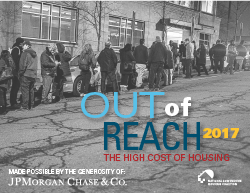
Out of Reach 2017: The High Cost of Housing
NLIHC released Out of Reach 2017 on June 8. The report’s Housing Wage is the hourly wage a full-time worker must earn to afford a modest apartment while spending no more than 30% of his or her income on rent and utilities. This year, the national two-bedroom Housing Wage is $21.21 per hour. A household must have an annual income of at least $44,120 to afford a two-bedroom rental home at HUD’s average Fair Market Rent (FMR) of $1,103 per month. The average hourly wage of renters in the U.S. is $16.38, which is $4.83 less than the two-bedroom Housing Wage. The federal minimum wage is $13.96 less than the Housing Wage, requiring a full-time minimum wage earner to work 117 hours per week, 52 weeks a year to afford a two-bedroom apartment. Despite a minimum wage higher than the federal level in a growing number of states and jurisdictions, in no state, metropolitan area, or county can a full-time minimum-wage worker afford a modest two-bedroom rental home.
Six of the seven occupations projected to add the most jobs between 2014 and 2024 provide a median wage lower than the national Housing Wage. Personal care aids, expected to add 450,000 jobs, earn a median wage of $10.75 an hour, or $10.46 less than the two-bedroom Housing Wage. Home health aides earn a median wage of $11.09 per hour, or $10.12 less than the two-bedroom Housing Wage.
At the state level, the two-bedroom Housing Wage ranges from $13.72 per hour in Arkansas to $35.20 per hour in Hawaii. Hawaii, California, and the District of Columbia have a Housing Wage higher than $30 per hour. Sixteen states and the District of Columbia have a Housing Wage higher than $20 per hour.
The lowest income renters face the greatest challenges finding affordable housing. Extremely low income (ELI) renter households are able to afford a monthly rent of only $523, far less than the monthly FMR of $1,103 for a two-bedroom home and $892 for a one-bedroom home. As a result, ELI renter households account for 73% of all severely cost-burdened renter households in the U.S. who spend more than half of their income on housing.
NLIHC released Out of Reach 2017 with a media call featuring Representative Keith Ellison (D-MN), who wrote the preface to this year’s report, NLIHC President and CEO Diane Yentel, and NLIHC Vice President of Research Andrew Aurand. Mr. Ellison recently reintroduced the “Common Sense Housing Investment Act of 2017” (H.R. 948), which reflects the goals of the NLIHC-led United for Homes campaign. The bill proposes lowering the amount of a mortgage eligible for a tax break from $1 million to $500,000 and replacing the deduction with a tax credit. These two modest reforms would generate $241 billion in savings to be directed to the Housing Trust Fund, public housing, rental assistance, and other rental housing solutions for the most financially vulnerable renters.
The Out of Reach 2017 website is at: http://nlihc.org/oor
The full Out of Reach 2017 report is available at: http://bit.ly/2sY6q5R
